The above map was added to the “Calender Date” entry at Wikipedia on December 28, 2007 by Wikipedia user Garden. The map was color coded each country by the date format(s) used.
The map was edited (by color) twelve (12) times and the last edit was conducted about a year later on December 8, 2008. Most of the edits were done by Wikipedia user Kwamikagami.
On the 6th edit (on October 29, 2008) the color of the country Kenya was changed to purple. The color purple indicated that a country used both MM/DD/YYYY and DD/MM/YYYY. That map is shown below:
Kenya remained purple throughout all of the future edits.
The map was removed from Wikipedia on November 17, 2010 by Wikipedia user Worm That Turned. They noted that, “Map is just wrong, and causing a contradiction. If anyone fancies correcting the map, feel free to put it back.”
NOTE: As of January 2011 date formats are compiled in entry at Wikipedia called, “Date format by country.” And the entry also contains a color coded map.
I have been writing this report for, at least, more than a year now. The title was originally titled “Wiki admin Kwamikagami and the Kenya date formats (British English and Kenyan Swahili) and Mystylplx the power-scrubbing Obot.” Here is a screenshot with last edit of “March 12, 2013”: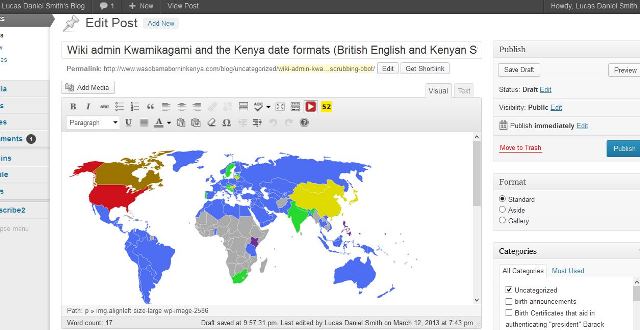
I never finished writing the report, although I tried on many occasions, because it was just to complex to pool or bundle together into something that could be read and understood.
However, I’ve recently received requests from specific parties requesting that I publish another compelling report on the date format used on Barack Obama’s 1961 Coast Province General Hospital, Mombasa, British Protectorate of Kenya birth certificate.
Additional motivation to finishing writing the report appeared in the form of Dr. Conspiracy publishing an article yesterday (April 1st, 2011) called “Wikipedia was in the forefront of the battle over the Smith birth certificate.”
In the article Dr. Conspiracy finally admits that Kenya uses two (2) different numeric date formats (i.e., MM/DD/YYYY and DD/MM/YYYY), “Indeed, it has m/d/yyyy formatting for “Kiswahili (Kenya).”
However, in a despairing last-ditch attempt to not have to admit that the skeptics (and worse) were wrong for last five (5) years, he goes on to state that, “It is important to understand that this entry is not for Kenya, but for the national language Kiswahili.”
(Dr. Conspiracy has now, as of approximately noon on April 2nd, 2014, removed that second sentence from his article but it can still be found in the duplicate at the Beforeitsnews.com website. Moreover, instead of using strikethrough text, to indicate an edit or alteration, he chose to deleted the sentence.)
There are a few things wrong with Dr. Conspiracy’s second statement regarding Kiswahili.
To begin with, Kiswahili is not the “national language” of Kenya, it is the official language of Kenya just as English is. Both English and Kiswahili are the official languages in Kenya.
Furthermore, it doesn’t matter whether or not Kiswahili is the national language or the official language of Kenya. Kiswahili, or Swahili, is the indigenous language of the coastal areas of Kenya and Tanzania.
How do I know that Kiswahili, or Swahili, is the indigenous language of the coastal areas of Kenya and Tanzania.? For starters, I own and have read the following books (that’s my Yahama motorcycle in the background that I drove to the Policia Nacional Palaca and the Presidential Palace the other day):
That first book you see there is Swahili-Speaking People of Kenya’s Coast 1895-1965 by A.I. Salim (1973). Below is a picture of the very interesting backside of the book. Not only is it interesting because it includes information regarding the author and his picture but also because it says “sh 35.00 in East Africa.” Skeptics would likely call that a forgery if it were printed on any other post-independence or post-colonialism document.
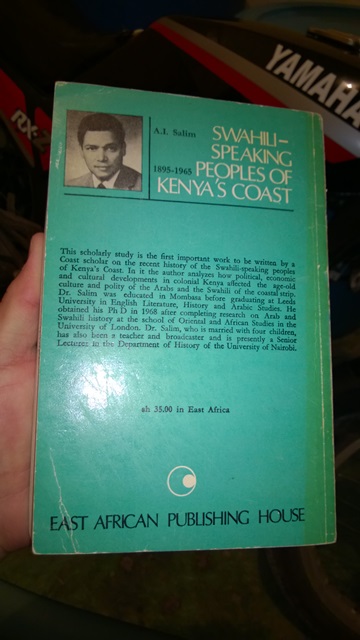 The second book is A Kiswahili Instruction book for the East Africa Command prepared by the East African Army Education Corps and printed by the Government Printer, Entebbe, Uganda (1942).
The second book is A Kiswahili Instruction book for the East Africa Command prepared by the East African Army Education Corps and printed by the Government Printer, Entebbe, Uganda (1942).
I find it interesting that A Kiswahili Instruction book for the East Africa Command can be found on Google Books (here) and even has a picture of the same cover of my book but it is not the same book. How do I know? I know because the Google Book version is searchable, you can look inside the book (not full pages though).
Mine is the original 107 page edition of A Kiswahili Instruction book for the East Africa Command while Google Books has a 141 page edition. At first I thought that it was still the same 107 pages with 34 additional pages of information. However, I soon discovered that that was not the case, and that while some of the book was the same, much of it had been rewritten.
I also wrote about Swahili “time” over a year ago (March 13, 2o13) and published a report here at the WOBIK blog which was titled, What time is it in Kenya? In Kenya not only do they use at least two different numeric date formats they also use two different time/clock systems. In Kenya they use the standard time system that we as Americans (and most of the rest of the world) use and they also use Swahili time (or Kiswahili time).
In Swahili time there are 12 hours of night and 12 hours of day. At our 7:00 in the morning it is 1:00 in the morning in Swahili time. At our 9:00 in morning it is 3:00 in the morning in Swahili time. At our 12 o’clock (noon) it is 6:00 o’clock in Swahili time. At our 3:00 o’clock it is 9:00 o’clock in Swahili time. At our 6:00 o’clock it is 12:00 o’clock in Swahili time. At hour 9:00 o’clock at night it is 3:00 o’clock in Swahili time. At our 12:0o o’clock at night it is 6:00 o’clock at night in Swahili. At our 3:00 in the morning it is 9:00 o’clock at night in Swahili time. At our 6:00 in the morning it is 12 o’clock in Swahili time.
How does anyone in Kenya, including all Kenyans, know which time system is being used if both systems are used?
This different time system in Kenya also affects the date: the whole night is the same date as the preceding day. For example, Tuesday does not become Wednesday until morning breaks, rather than changing at midnight.
Has the dual time system ever caused confusion in East Africa? It appears most of the people who have trouble with it are foreigners, and here are a three (3) true stories:
A.
Professor Erin Wilkinson (American) couldn’t understand why she was “stood up” when she scheduled small business client appointments at 2:00pm and 4:00pm in Zanzibar and Tanzania.
http://zanzibaradventure.wordpress.com/
B.
Foreigner in Tanzania misses class because “2:40″ to her surely meant 2:40 in the afternoon.
Turns out it was Swahili time which in standard time was 8:40 in the morning:
“So, while attempting to schedule one of these visits, I encountered a pretty interesting cultural miscommunication. One of the teachers whose class we wanted to sit in on sent me a text message (SMS) saying her class was at 2:40. Of course, I took this to mean 2:40pm. Since this was only one of many visits I was scheduling, it did not occur to me until the day of our visit that that time could not be correct since schools are only in session until 2:00pm everyday. By the time I realized this it was already 8:30am or so, and shortly after my realization the teacher called me to ask if I was going to be there that day. When I asked her to clarify the time she said “Oh, I am in the class right now!” Turns out that when she said 2:40, she meant class was at 8:40am – i.e. six hours past the time she told me. This was really puzzling to me, but apparently there is a separate “Swahili” time and “English” time. While I and most of the world functions on “English” time, in some Swahili speaking nations they consider 1:00am to be one hour after the sun rises, which would correspond to what most people consider 7:00am, and 1:00pm to be one hour after the sun sets, which would correspond to what most people consider 7:00pm. So, the time they provide you might be six hours off, as was the case with the teacher I communicated with. Now that I know this, I try to clarify whether they mean “Swahili time” or “English time” time when I try to schedule meetings so that I won’t be six hours late or early!”
http://isteptanzania.wordpress.com/2009/07/17/you-mean-swahili-time-or-english-time/
C.
Tourists in Tanzania buy boat ticket which they thought was leaving at 8:00 pm:
“While we had thought that the boat would depart at 8:00 p.m (because it said 8:00 p.m. on our ticket), we were wrong. Our boat was going to leave at 2:00 in the afternoon. The time on our ticket was “Swahili time,” not “Western time.” They learned that in Swahili time, the day starts at sunrise (makes sense), which, at the equator does not change substantially during the year, so what we think of as 6:00 a.m. is considered 1:00 a.m. in Swahili time. To make matters even more confusing (at least for us), the people here keep their watches on Western time, but convert to Swahili time. So much for our mastery of Swahili.”
http://www.oocities.org/mimi_samuel/mikandani.htm
Enough about Swahali time. Lets move on to something even more thought-provoking:
Kwamikagami
What is a Kwamikagami? It’s a person, or at least it’s their user name at Wikipedia, that I originally wanted to talk about a length but I’ve since scrapped that idea and deleted several paragraphs because it’s just to complex, compound and generally confusing. In any event, this person is a very active member of Wikipedia and they write a lot about languages on Wikipedia.
He (or she) also provided the external references for Kenya’s use of the MM/DD/YYYY and DD/MM/YYYY date formats.
Mystylplx
To be brief, (which was absolutely not my original plan, and several paragraphs have been deleted) Mystyplx is what is known online as an “Obot.” For a few years they stalked me on the internet and, especially on my Youtube forum (now closed to new comments), and spread lies and disinformation was, as Obots go, exceptionally rude and relentless.
On the following dates, and probably other dates as well, they were present at the Calander Date entry at Wikipedia squawking and screeching about the the dual date format (i.e., MM/DD/YYYY and DD/MM/YYYY) for Kenya: 05:41, 26 August 2009, 20:32, 26 August 2009, 00:05, 31 August 2009, 00:07, 31 August 2009, 19:54, 31 August 2009, 20:00, 31 August 2009, 20:01, 31 August 2009, 08:21, 15 September 2009, 08:22, 15 September 2009, 17:50, 19 September 2009.
Nowadays Mystylplx hangs out on Wikipedia at such entries as listed below:
1. Birthright citizenship in the United States
2. Natural-born-citizen clause
3. Barack Obama citizenship conspiracy theories
Conclusion:
In Kenya dates can be listed in Kiswahili format (MM/DD/YYYY) or English format (DD/MM/YYYY).
See also:
Letters from esteemed Kenyan hero Thomas Joseph Odhiambo Mboya and his diverse date formats.
and
and
Please exercise your free speech in the comments section below. There are no stipulations of political correctness on this blog. Speak your mind, give us your thoughts, both objective and subjective. Share your ideas, hunches, inklings or your expertise. Please provide recommendation and corrections if you spot errors in fact within the blog report. Lastly, remember that posting a comment is much like casting a vote, so please do so.

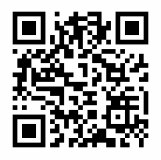
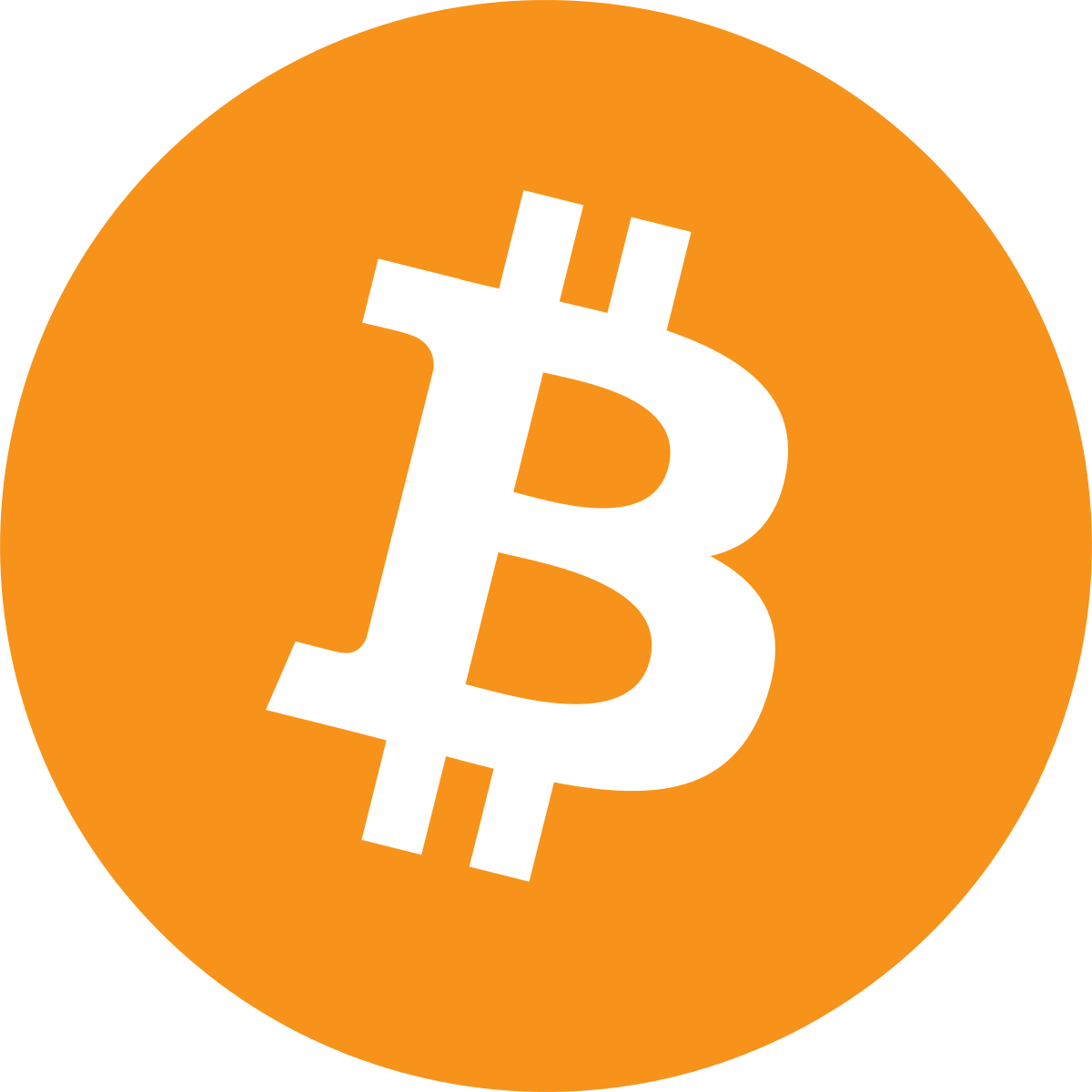
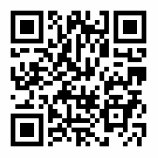

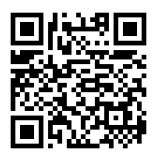

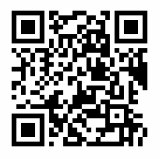

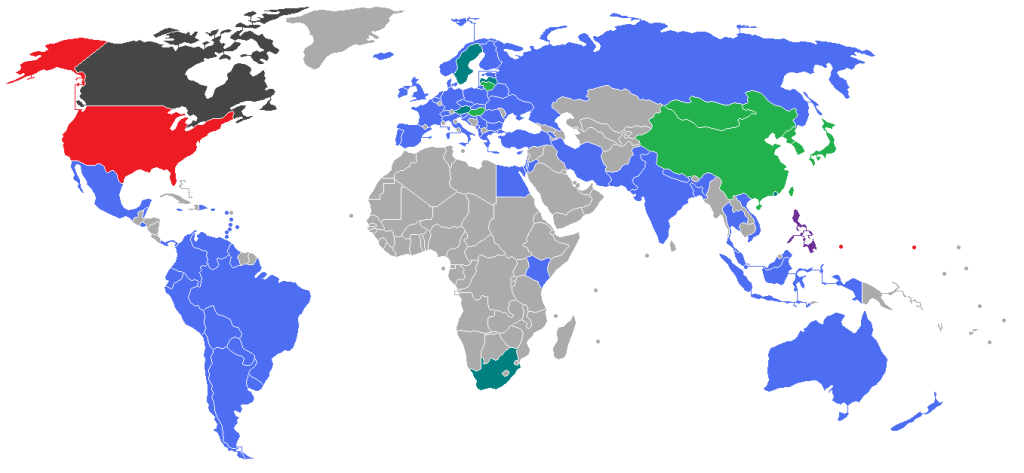
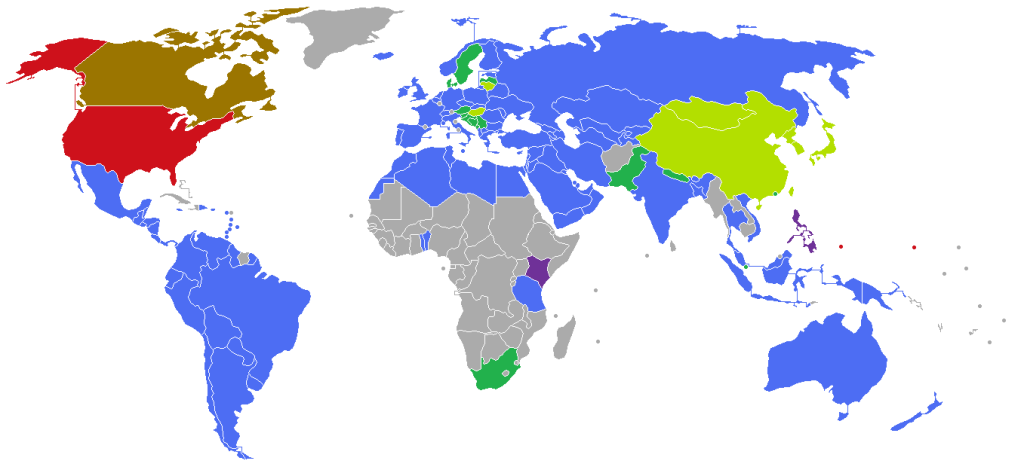
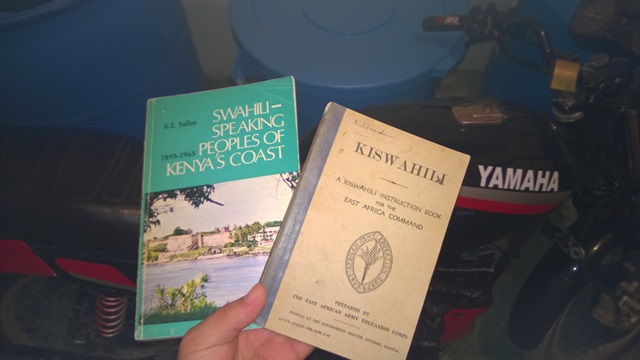
Lucas,
CONGRATULATIONS on a masterful job in researching and presenting an important and very complex topic.
I have added a reference to this post on the InspectorSmith Forum under the sub-forum ‘ The Date Format (M/D/Y) Used on the ‘LDS, Obama Kenyan BC’ is Authentic’
http://www.wasobamaborninkenya.com/InspectorSmith/showthread.php/940-The-Date-Format-%28M-D-Y%29-Used-on-the-LDS-Obama-Kenyan-BC-is-Authentic
Amazing, not only do you add 2+2 and get 5, but you do so in the most wordy way possible. Oh you’ll see Obama out of office alright. Inauguration day 2017.
So if Wikipedia says Germany is on the list of countries using 5-digit zip codes, it proves Germany used 5-digit zip codes in 1961? (Hint: Germany moved from 4-digit to 5-digit zip codes in 1992.)
You can yap about what Wikipedia says what Kenya is doing *now* until the cows come home – what’s interesting is what Kenya did in 1961.
Also, as usual you try to go off on a massive tangent about “Kiswahili time” which absolutely has no probative value on any claims about different *date* formats.
Only someone with the attention span of an ADD patient would “forget” you were supposed to be talking about dual date format usage.
(Just like your claims how sometimes official documents have typos tried to distract from the fact the guy who signed your “Obama BC” wrote his name wrong when he *signed* it.)
It’s like claiming your uncle can’t read because he can’t add.
This is street magician 101, but it doesn’t work with an audience that is more intelligent than the average birther.
You conclude that:
“In Kenya dates can be listed in Kiswahili format (MM/DD/YYYY) or English format (DD/MM/YYYY).”
Since both of your offered birth certificates are in English exclusively, there is no reason for either to use Kiswahili format.
Bruce wrote:
Thank you Bruce!
Definitive and categorical proof that Kenya uses two different numeric date formats. D/M/Y & M/D/Y.
Interesting note:
On July 4, 1974 President Jomo Kenyatta declared Kiswahili a Parliamentary language.
http://webcache.googleusercontent.com/search?q=cache:ky7OsPyW7dUJ:www.standardmedia.co.ke/%3FarticleID%3D2000017118%26story_title%3Dkiswahili-becomes-kenya-official-language+&cd=1&hl=en&ct=clnk&gl=do
@ Vox Reasoni:
Which is latin for, shoe shine boy.
IF you had actually gone to Kenya and gotten Obama’s birth certificate in Mombasa, as you have claimed, you would be able to show proof of that alleged trip to Kenya by showing a US passport page with a Kenya stamp on it. You have been asked to show it many times, but you never have. (I wonder why not???)
@ ellen:
Is this the same Ellen also known as ehancock that called the usurpers mother a “mudsharking slut” right here on this site a while back? Are you that same racist troll?
the date format has never been the problem. What a waste of time !